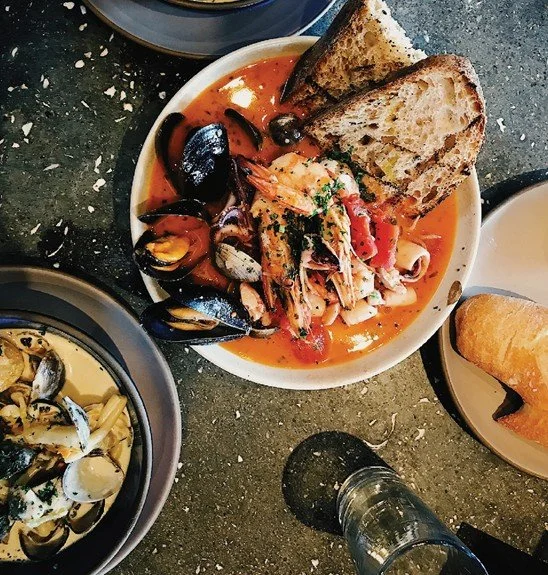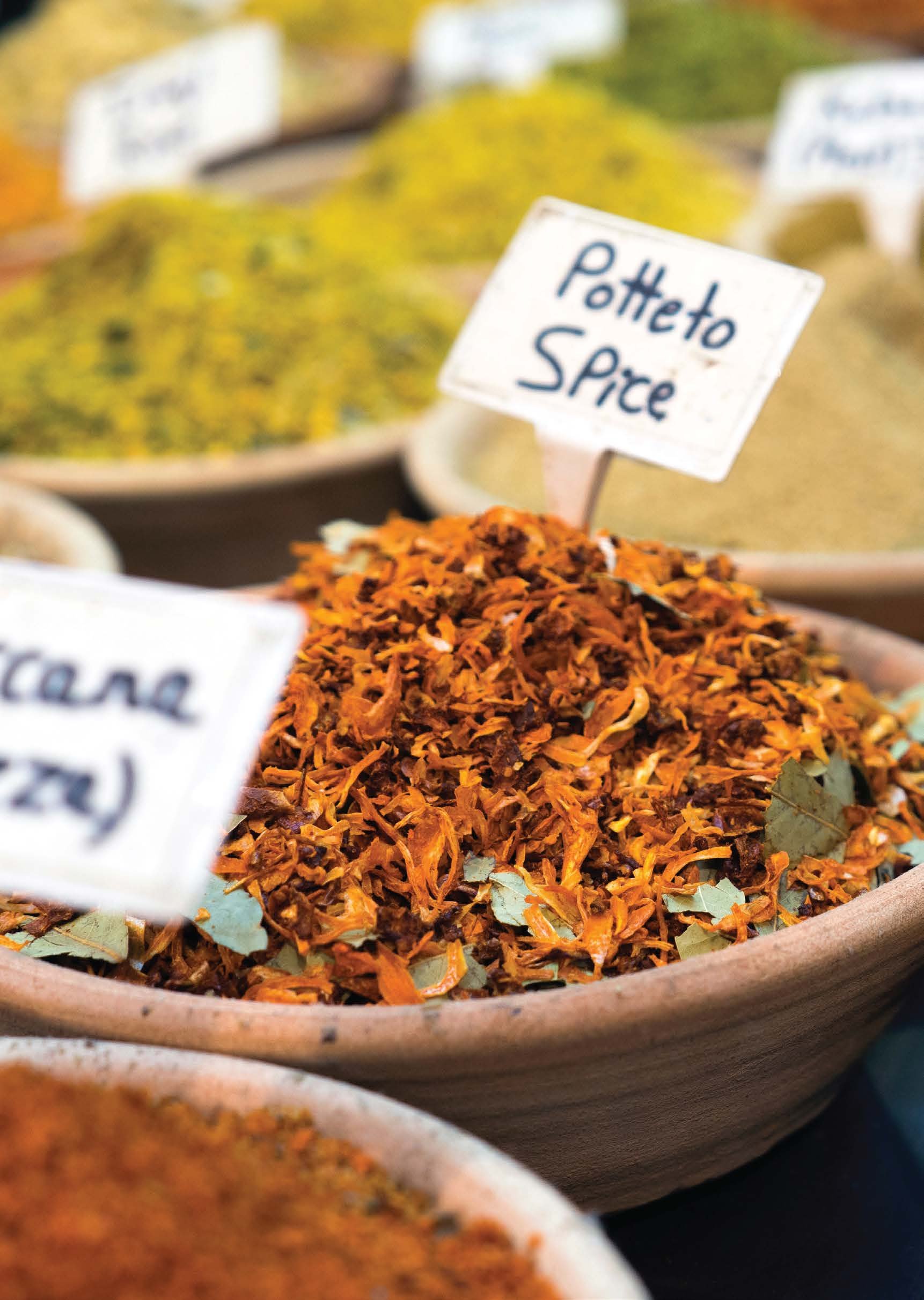ECLECTIC APPETITES
WORDS BY EMMA TAYLOR
Fusion food may be a contemporary trend, but it is also a culinary practice that goes back centuries, to the early days of international trade routes. Fusion food is more than just recipes—it is the sharing of histories, knowledge and tradition.
Modern Australian cuisine is extremely difficult to define. It is diverse and eclectic. If you asked ten Melburnians what they had for dinner last night, their responses are likely to span the vast variety of international influences that we’ve become accustomed to enjoying in our bustling city. Melbourne’s foodscape has changed drastically over time. Many of these changes have been driven by Australia’s history of colonisation and immigration. Aside from the traditional owners of the land—Australia’s Indigenous people—Australia is inhabited by migrants from Europe, Asia, Africa, the Middle East and the Americas. Whether we realise it or not, our food is characterised by a weaving of flavours and styles from across the globe.
Like language or art, the food we eat is constantly evolving. Food fusion may be a contemporary term, but it is a practice with a long history. While the Spice Route is famous for bringing modern-day staples like cinnamon, nutmeg and pepper from East to West (not to mention the less appetising side effect of colonisation), in the earliest days of international trade, travellers and merchants would share meals and exchange recipes and food knowledge. Dishes have become more diverse and interesting as a result, combining contrasting ingredients and cooking methods towards more evolved and complex dishes.
Some of the food staples we take for granted have evolved based on early intercultural trade. The most Italian of foods—pasta—is actually thought to be the descendant of Chinese noodles, brought to Europe by Marco Polo in the thirteenth century. Ramen—the Japanese (and poor student) staple—is apparently also a descendant of the Chinese noodle, adapted during the power struggles of the nineteenth century between Japan and China. Similarly, curry vindaloo is an Indian version of a Portuguese stew, evolved with local spices during the Portuguese rule of Goa in southern India. The Vietnamese sandwich staple, bánh mì, is also a derivative of colonial rule. Emerging in the wake of the First World War, it combines the French baguette with local Vietnamese meats and spices. Refugees fleeing the Vietnam War then brought the sandwich to Melbourne, where it is now ubiquitous and regularly adapted to local tastes, with vegetarian and vegan options easy to come by.
***
My mum grew up in regional Wagga Wagga in the sixties and seventies. She grew up in a working-class family whose meals were a continuation of their British heritage.
‘It was mostly meat and three veg, and the vegetables were cooked up to nothing. There was always lots of salt as seasoning in an attempt to give the food flavour, but it was still bland.’
The increase in Australian immigration during her teenage years—accompanied by new restaurants and cafés to cater to the new populations—expanded her foodscape. Her lifelong love of rich, sticky-sweet baklava came out of her first time dining in a Lebanese restaurant, which I suspect also influenced her love of Middle Eastern flavours.
Mum’s limited food experiences growing up had a significant impact on my upbringing. In contrast to her childhood, she brought the diversity of food that existed around us—outside of our heritage and culture—into our home. It wasn’t until later in my teen years that I realised my family dinners almost always embraced the flavours, techniques and dishes of different cultures. When I was growing up, we had a number of staple dishes—soul-soothing hot pumpkin soups served with a dollop of cream, rustic layered lasagne accompanied by olive oil-soaked roasted vegetables, and crispy fried ricotta—all of which are borrowed, found, and adapted recipes. The food I ate growing up—and the food that I still eat today—was influenced by the numerous cultures and people that have become an integral part of Melbourne’s foodscape.
***
The term ‘food fusion’ in its contemporary incarnation is attributed to celebrity chef Wolfgang Puck, who, working in Los Angeles in the eighties, began to infuse traditional European dishes with Asian flavours. Today, in a city like Melbourne, food culture and a diverse population have combined to make food fusion part and parcel of our everyday dining and cooking experiences. Indeed, food fusion is so commonplace in Melbourne that the term is rarely used (or needed) anymore—what was once called ‘food fusion’ is these days known as globally inspired, cross-cultural or, simply, contemporary Australian cuisine.
Melbourne’s diverse food culture has a storied history. In the 1860s, capitalising on the gold rush, Chinese migrants began to buy land on Little Bourke Street. What began as a place for Melbourne’s Chinese community to congregate soon became what we now know as Chinatown. One of the CBD’s most famous streets, stroll along and take your pick: feast on cheap dumplings and cold beer or dine out on delicate duck pancakes in five-star surrounds.
The post-Second World War era was when Melbourne’s foodscape really began to change and expand. Today, Melbourne is renowned for its coffee culture, thanks to the Italian migrants of the fifties, who brought with them the first espresso machine. And with it, a burgeoning café culture that has spread from Lygon Street in Carlton, through the city and into the suburbs. The Greek migrants of the same era brought with them the souvlaki that is now considered standard late-night fare for drunk revellers. Victoria Street in Richmond became known as ‘Little Saigon’ as Vietnamese refugees fleeing the Vietnam War in the seventies opened restaurants and grocery stores along the strip.
It didn’t take long for these new flavours, dishes and cooking techniques to combine with one another (and with local foods), catalysing the culinary culture that has made Melbourne an international destination for food lovers. Brunch at your local café can include everything from avocado toast with miso drizzle through to panko-crumbed fried eggs, and traditionally Asian condiments—from soy to sambal—are liberally used on everything from breakfast to burgers. Pizza in Melbourne ranges from traditional Italian to more locally inspired—think: bush tomato, capsicum and emu! There are also, of course, the more outlandish combinations, from the passing fad of the cronut (an artery-clogging fusion of the French croissant and American donut) to Korean tacos.
A recent evolution in contemporary Australian cuisine is the inclusion of native Indigenous flavours and ingredients—from kangaroo to lemon myrtle—into a range of dishes. The cookbook Warndu Mai is a beautiful example of how to use previously overlooked native spices and herbs.
‘Brunch at your local café can include everything from avocado toast with miso drizzle through to panko-crumbed fried eggs.’
When it comes to restaurants, Anchovy in Richmond is currently Melbourne’s most celebrated for its use of native Australian ingredients. Described as ‘modern Asian, modern Australian and a little bit in between’, their menu combines the South-east Asian culinary roots of its owner-chefs with distinctly Australian ingredients in a true fusion of flavours. Think: Vegemite-spiked leek tempura, Coke-marinated pork chops with Asian greens and Moreton Bay bug with fish sauce and chilli.
***
In my own cooking, I find myself adapting recipes and combining different ingredients that aren’t traditionally paired. My favourite dish is lemon chicken linguine: an Asian and Italian fusion of flavours that works beautifully—unsurprising, considering the Chinese origin of pasta! Of course, food fusion is about more than what appears on the plate. Food is something that brings people together—breaking bread implies not simply sharing a table but also sharing time and space and stories. The most enriching experiences come from sharing traditions and learning about different cultures—where better to start than on the plate.
PICK OF THE MIX
ANCHOVY
338 Bridge Road, Richmond
Anchovy’s reputation for experimentation, eclectic flavour combinations, and exceptional dining experience is well deserved. Their menu comprises Asian-Australian fusion dishes that speak to the owners’ heritage and to modern tastes.
HANOI HANNAH VOL. II
306 Glen Huntly Road, Elsternwick
Initially conceived to bring Vietnamese cuisine south side, Hanoi Hannah, with its hipster-kitsch aesthetic, is now a veritable institution. Its thoughtful menu boasts everything from classics like rice paper rolls to fusions like Vietnamese tiramisu.
HOCHI MAMA
11 Liverpool Street, Melbourne
Another Vietnamese fusion offering, Hochi Mama, is a playful offering from three high school friends. The menu is creative—think: Vietnamese sushi, pho’plings (pho + dumplings), lime juice cocktails—and the hip-hop soundtrack keeps it fun.
CHOTTO MOTTO
287 Wellington Street, Collingwood
This new gyoza bar is the latest offering from local restaurateur Tamoya Kawasaki. The decor is total Japanese kitsch—complete with vintage posters and Kewpie dolls—and the menu includes chickpea gyoza, fries with furikake and soft serve for dessert.
MAMASITA
Level 1/11 Collins Street, Melbourne
This Melbourne classic is the place to go for Mexican food with a contemporary twist. The menu changes seasonally, but always includes creative takes on staples like tacos and tostadas. The decor is Mexican restaurant meets American diner!


